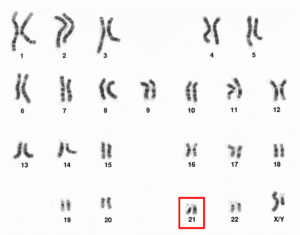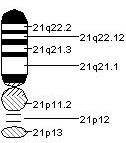كروموسوم 21 (بشري)
| كروموسوم 21 (بشري) | |
|---|---|
 Human chromosome 21 pair after G-banding. One is from the mother, one is from the father. | |
 Chromosome 21 pair in human male karyogram. | |
| السمات | |
| Length (bp) | 45,090,682 bp (CHM13) |
| No. of genes | 215 (CCDS)[1] |
| Type | Autosome |
| Centromere position | Acrocentric[2] (12.0 Mbp[3]) |
| قوائم الجينات الكاملة | |
| CCDS | Gene list |
| HGNC | Gene list |
| UniProt | Gene list |
| NCBI | Gene list |
| متصفحات الخرائط الخارجية | |
| Ensembl | Chromosome 21 |
| Entrez | Chromosome 21 |
| NCBI | Chromosome 21 |
| UCSC | Chromosome 21 |
| تسلسلات الدنا الكاملة | |
| RefSeq | NC_000021 (FASTA) |
| GenBank | CM000683 (FASTA) |
الكروموسوم 21، هو واحد من 23 زوج من الكروموسومات البشرية. عادة ما يمتلك البشر زوجان من هذا الكروموسوم. التثلث بهذا الكروموسوم يسبب متلازمة داون. الكروموسوم 21 هو أصغر كروموسوم بشري، ويحتوي على 47 مليون نيوكليوتيد (مادة بناء الدنا)، ويمثل حوالي 1.5% من إجمالي الدنا في الخلايا.
في 2000، أعلن الباحثون العاملون على مشروع الجينوم البشري أنهم قاموا بتحديد تسلسل الأزواج القاعدية المكونة لهذا الكروموسوم. الكرومسوم 21 كان ثاني كروموسوم بشري يتم تحديد تسلسله بالكامل، بعد الكروموسوم 22.
نظراً لاختلاف المناهج التي يستخدمها الباحثون في التنبؤ بعدد الجينات في كل كروموسوم، هناك تباين في أعداد الجينات المقدرة. من الأرجح أن الكروموسوم 21 يحتوي على 300-400 جين.
الجينات
القائمة التالية لبعض الجينات الموجودة على الكروموسوم 21:
- APP: amyloid beta (A4) precursor protein (peptidase nexin-II, Alzheimer disease)[4]
- C21orf59: Chromosome 21 open reading frame 59
- CBS: cystathionine-beta-synthase
- CLDN14: claudin 14
- HLCS: holocarboxylase synthetase (biotin-(proprionyl-Coenzyme A-carboxylase (ATP-hydrolysing)) ligase)
- KCNE1: potassium voltage-gated channel, Isk-related family, member 1
- KCNE2: potassium voltage-gated channel, Isk-related family, member 2
- LAD: leukocyte adhesion deficiency (symbols are ITGB2, CD18, LCAMB)
- SOD1: superoxide dismutase 1, soluble (amyotrophic lateral sclerosis 1 (adult))
- TMPRSS3: transmembrane protease, serine 3
- PCNT: centrosomal pericentrin
- DSCR1: Down Syndrome critical region 1[5]
- DYRK1A: dual specificity tyrosine-(Y)-phosphorylation regulated kinase 1A
- RRP1B: ribosomal RNA processing 1 homolog B
- s100B: calcium binding protein
الأمراض والاضطرابات
القائمة التالية لبعض الأمراض المرتبطة بالجينات الموجودة على الكروموسوم 21:
- مرض ألزيامر[4]
- Amyotrophic lateral sclerosis
- Autoimmune polyendocrine syndrome
- متلازمة داون
- متلازمة إرندو-سيمت
- Holocarboxylase synthetase deficiency
- Homocystinuria
- متلازمة جرڤل ولانگ-نايلسن
- Leukocyte adhesion deficiency
- Majewski osteodysplastic primordial dwarfism type II (MOPD II, or MOPD2)
- Nonsyndromic deafness
- متلازمة رومانو-وارد
حالات كروموسومية
الحالات التالية تحدث بسبب تغيرات في بنية أو عدد نسخ كروموسوم 21:
- السرطان: Rearrangements (translocations) of genetic material between chromosome 21 and other chromosomes have been associated with several types of cancer. For example, acute lymphoblastic leukemia (a type of blood cancer most often diagnosed in childhood) has been associated with a translocation between chromosomes 12 and 21. Another form of leukemia, acute myeloid leukemia, has been associated with a translocation between chromosomes 8 and 21.
- في حالات قليلة، متلازمة داون قد تحدث by a rearrangement of chromosomal material between chromosome 21 and another chromosome. As a result, a person has the usual two copies of chromosome 21, plus extra material from chromosome 21 attached to another chromosome. These cases are called translocation Down syndrome. Researchers believe that extra copies of genes on chromosome 21 disrupt the course of normal development, causing the characteristic features of Down syndrome and the increased risk of medical problems associated with this disorder.
- Other changes in the number or structure of chromosome 21 can have a variety of effects, including mental retardation, delayed development, and characteristic facial features. In some cases, the signs and symptoms are similar to those of Down syndrome. Changes to chromosome 21 include a missing segment of the chromosome in each cell (partial monosomy 21) and a circular structure called ring chromosome 21. A ring chromosome occurs when both ends of a broken chromosome are reunited.
- Duplication in Amyloid precursor protein (APP) locus (duplicated segment varies in length but includes APP) on Chromosome 21 was found to cause early onset familial Alzheimer's disease in a French family set (Rovelet-Lecrux et al.) and a Dutch family set [4]. Compared to Alzheimer's caused by missense mutations in APP, the frequency of the Alzheimer's caused by APP duplications is significant. All patients that have an extra copy of APP gene due to the locus duplication show Alzheimer's with severe cerebral amyloid angiopathy.
المصادر
- ^ خطأ استشهاد: وسم
<ref>غير صحيح؛ لا نص تم توفيره للمراجع المسماةCCDS - ^ Tom Strachan; Andrew Read (2 April 2010). Human Molecular Genetics. Garland Science. p. 45. ISBN 978-1-136-84407-2.
- ^ Genome Decoration Page, NCBI. Ideogram data for Homo sapience (850 bphs, Assembly GRCh38.p3). Last update 2014-06-03. Retrieved 2017-04-26.
- ^ أ ب ت Sleegers K,Brouwers N,Gijselinck I,Theuns J, Goossens D, Wauters J,Del-Favero J,Cruts M, van Duijn CM,Van Broeckhoven C. (2006). "APP duplication is sufficient to cause early onset Alzheimer's dementia with cerebral amyloid angiopathy". Brain. 129 (Pt 11): 2977–83. doi:10.1093/brain/awl203. PMID 16921174.
{{cite journal}}: CS1 maint: multiple names: authors list (link) - ^ Gardiner K, Davisson M (2000). "The sequence of human chromosome 21 and implications for research into Down syndrome". Genome Biol. 1 (2): REVIEWS0002. doi:10.1186/gb-2000-1-2-reviews0002. PMC 138845. PMID 11178230.
{{cite journal}}: CS1 maint: unflagged free DOI (link)
- Antonarakis SE, Lyle R, Dermitzakis ET, Reymond A, Deutsch S (2004). "Chromosome 21 and down syndrome: from genomics to pathophysiology". Nat Rev Genet. 5 (10): 725–38. doi:10.1038/nrg1448. PMID 15510164.
{{cite journal}}: CS1 maint: multiple names: authors list (link) - Antonarakis SE, Lyle R, Deutsch S, Reymond A (2002). "Chromosome 21: a small land of fascinating disorders with unknown pathophysiology". Int J Dev Biol. 46 (1): 89–96. PMID 11902692.
{{cite journal}}: CS1 maint: multiple names: authors list (link) - Antonarakis SE (2001). "Chromosome 21: from sequence to applications". Curr Opin Genet Dev. 11 (3): 241–6. doi:10.1016/S0959-437X(00)00185-4. PMID 11377958.
- Gilbert F (1997). "Disease genes and chromosomes: disease maps of the human genome. Chromosome 21". Genet Test. 1 (4): 301–6. doi:10.1089/gte.1997.1.301. PMID 10464663.
- Hattori M, Fujiyama A, Taylor TD, Watanabe H, Yada T, Park HS, Toyoda A, Ishii K, Totoki Y, Choi DK, Groner Y, Soeda E, Ohki M, Takagi T, Sakaki Y, Taudien S, Blechschmidt K, Polley A, Menzel U, Delabar J, Kumpf K, Lehmann R, Patterson D, Reichwald K, Rump A, Schillhabel M, Schudy A, Zimmermann W, Rosenthal A, Kudoh J, Schibuya K, Kawasaki K, Asakawa S, Shintani A, Sasaki T, Nagamine K, Mitsuyama S, Antonarakis SE, Minoshima S, Shimizu N, Nordsiek G, Hornischer K, Brant P, Scharfe M, Schon O, Desario A, Reichelt J, Kauer G, Blocker H, Ramser J, Beck A, Klages S, Hennig S, Riesselmann L, Dagand E, Haaf T, Wehrmeyer S, Borzym K, Gardiner K, Nizetic D, Francis F, Lehrach H, Reinhardt R, Yaspo ML (2000). "The DNA sequence of human chromosome 21". Nature. 405 (6784): 311–9. doi:10.1038/35012518. PMID 10830953.
{{cite journal}}: CS1 maint: multiple names: authors list (link) - Sawinska M, Ladon D (2004). "Mechanism, detection and clinical significance of the reciprocal translocation t(12;21)(p12;q22) in the children suffering from acute lymphoblastic leukaemia". Leuk Res. 28 (1): 35–42. doi:10.1016/S0145-2126(03)00160-7. PMID 14630078.
- Rovelet-Lecrux A,Hannequin D,Raux G,Le Meur N,Laquerriere A, Vital A,Dumanchin C,Feuillette S,Brice A,Vercelletto M, Dubas F,Frebourg T,Campion D. (2005). "APP locus duplication causes autosomal dominant early-onset Alzheimer disease with cerebral amyloid angiopathy". Nature Genetics. 38 (1): 24–6. doi:10.1038/ng1718. PMID 16369530.
{{cite journal}}: CS1 maint: multiple names: authors list (link) - Anita Rauch, Christian T. Thiel, Detlev Schindler, Ursula Wick, Yanick J. Crow, Arif B. Ekici, Anthonie J. van Essen, Timm O. Goecke, Lihadh Al-Gazali, Krystyna H. Chrzanowska, Christiane Zweier, Han G. Brunner, Kristin Becker, Cynthia J. Curry, Bruno Dallapiccola, Koenraad Devriendt, Arnd Dörfler, Esther Kinning, André Megarbane, Peter Meinecke, Robert K. Semple, Stephanie Spranger, Annick Toutain, Richard C. Trembath, Egbert Voss, Louise Wilson, Raoul Hennekam, Francis de Zegher, Helmut-Günther Dörr, André Reis (2008). "Mutations in the Pericentrin (PCNT) Gene Cause Primordial Dwarfism". Science Online: 7.
{{cite journal}}: CS1 maint: multiple names: authors list (link)
